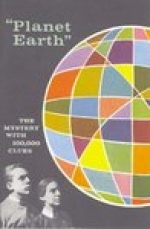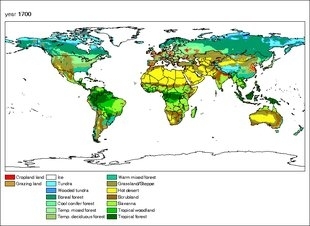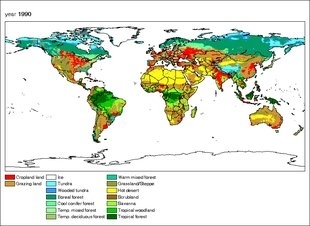Climate Literacy Handbook: Principle 6
| Topics: |
Previous: Principle 5 | Table of Contents (Climate Literacy Handbook: Principle 6) |Next: Principle 7
| Principle 6. Human activities are impacting the climate system. |
Essential Principle 6 relates to the causes and effects of human-induced climate change. For over 150 years the greenhouse effect has been described, and for over a century the potential for human activities to increase the temperature of the Earth through greenhouse gas emissions have been calculated. Despite this long history, some sectors of the public continue to debate whether these ideas can be true.
In 1958, the National Academy of Sciences published a booklet titled “Planet Earth: The Mystery with 100,000 Clues,” which contained this prescient paragraph:
Our industrial civilization has been pouring carbon dioxide into the atmosphere at a great rate. By the year 2000 we will have added 70 percent more carbon dioxide to the atmosphere. If it remained, it would have a marked warming effect on the earth’s climate, but most of it would probably be absorbed by the oceans. Conceivably, however, it could cause significant melting of the great icecaps and raise sea levels in time.
The authors accurately predicted many aspects of today's climate change in this paragraph. But they were off on several key points, as they did not anticipate the population of the planet more than doubling, and the demand for fossil fuel energy growing exponentially. In fact, from 1958 to the year 2000, the release of global fossil carbon emissions into the atmosphere rose from around 6,000 million metric tons (6 megatons) to around 30 megatons of CO2. Moreover, the authors of “Planet Earth” anticipated the ocean would absorb most of the carbon dioxide when in fact it currently absorbs only about 30%. They also did not recognize that as the ocean absorbs carbon dioxide, it also becomes acidic.
Articles in Depth:
Teaching Aids and External Resources:
- 1958 National Academies Posters
- Video: The Inconstant AirA film produced for the 1957-8 International Geophysical Year, describing the study of weather.
|
Concept 6a. The overwhelming consensus of scientific studies on climate indicates that most of the observed increase in global average temperatures since the latter part of the 20th century is very likely due to human activities, primarily from increases in greenhouse gas concentrations resulting from the burning of fossil fuels. |
While there is public debate about the attribution of recent climate change, it is not a strong feature of the discussions of climate scientists. or the peer reviewed literature. This is why this document uses the strong language “overwhelming consensus”. A variety of studies have noted that while most American adults believe climate change is happening, less than half of American adults think that climate scientists agree-- i.e., that there is a scientific consensus-- that human activities are a major cause of warming.
Peter Doran and Maggie Zimmerman of the Earth and Environmental Sciences, University of Illinois at Chicago published a study in 2009 of the survey results from 3146 Earth Scientists, finding that 97% of active climatologists agree that human activity is causing global warming. They noted: “It seems that the debate on the authenticity of global warming and the role played by human activity is largely nonexistent among those who understand the nuances and scientific basis of long-term climate processes."
Articles in Depth:
Teaching Aids and External Resources:
- IPCC: Frequently Asked QuestionsA series of short articles from the Intergovernmental Panel on Climate Change (IPCC), several of which relate to human attribution of climate change.
- Doran and Zimmerman 2009: Examining the Scientific Consensus on Climate ChangeResults of the scientist survey by Peter T . Doran and Maggie Kendall Zimmerman of the department of Earth and Environmental Sciences, University of Illinois at Chicago.
|
Concept 6b. Emissions from the widespread burning of fossil fuels since the start of the Industrial Revolution have increased the concentration of greenhouse gases in the atmosphere. Because these gases can remain in the atmosphere for hundreds of years before being removed by natural processes, their warming influence is projected to persist into the next century. |
Fossil fuels are very concentrated forms of transformed solar energy. It’s been estimated that one gallon of gasoline equals 98 tons of biomass. It is important to acknowledge that extremely powerful and portable forms of fossil fuel energy have been liberating in many respects, allowing machines to do work that would otherwise be done by human or animal muscle-power. The world has changed tremendously, socially, economically and environmentally due to fossil fuels.
The burning of fossil fuels, which releases carbon dioxide into the atmosphere, isn’t the only human contribution (also called "anthropogenic forcing") to climate change. However, human-generated carbon dioxide is considered the greatest contributor to recent climate change. It's important to “close the loop” in people’s understanding of how our food and our fossil fuel energy comes “from out of thin air” through photosynthesis. This can help develop people’s mental models and systems thinking: it’s all connected.
In an article in Science Magazine (October 24, 2008) entitled “Risk Communication on Climate: Mental Models and Mass Balance,” John D. Sterman notes that the “strong scientific consensus on the causes and risks of climate change stands in stark contrast to widespread confusion and complacency among the public. Why does this gulf exist, and why does it matter? “ He found that the vast majority of MIT graduate students examining a graph of projected CO2 emissions "underestimated and/or misunderstood what it would take to reduce the levels of CO2 concentrations in the atmosphere."
While we may not think in terms of stocks and flows in our everyday life, we experience them everytime we fill up a bathtub. As long as the faucet is adding more than the drain is letting out, the bathtub will continue to fill. Today we add roughly 9 megatons of carbon a year to the atmospheric reservoir, and about 4 megatons are removed a year through natural processes, meaning there is a net gain. Stabilizing the concentrations will require reducing the inflow to at lest the level of natural removal, and reducing the amount of concentration would require emissions that are lower than the natural removal.
Articles in Depth:
Teaching Aids and External Resources:
- Global Greenhouse Gas DataThree student-appropriate graphs and accompanying text describing the global human contribution of greenhouse gases to the atmosphere, from the Environmental Protection Agency.
- Lesson: What is the fate of CO2 produced by fossil fuel combustion?This college-level activity engages students in using a model to hindcast atmospheric CO2 increase during the industrial era, then forecast future concentrations of atmospheric CO2 during the next century.
- Energy Use By Humans- Rice UniversityThis set of articles about energy, energy transformation, and its use by humans was developed as a part of the Global Change Instruction Program by Arthur Few of Rice University and UCAR.
- Dukes, 2003: Burning buried sunshine: human consumption of ancient solar energyA study by Jeffrey Dukes estimating the equivalent amount of organic material that is consumed by fossil fuel use in one year, which appeared in Climatic Change, 61(1-2): 31-44.
|
Concept 6c. Human activities have affected the land, oceans, and atmosphere, and these changes have altered global climate patterns. Burning fossil fuels, releasing chemicals into the atmosphere, reducing the amount of forest cover, and rapid expansion of farming, development, and industrial activities are releasing carbon dioxide into the atmosphere and changing the balance of the climate system. |
As the global population grew from less than a billion people in the year 1700 to about six billion in the year 1990, the planet’s vegetation cover, albedo and hyrologic processes were also substantially altered. While releasing carbon dioxide from these activities is a key concern, methane from agriculture and wetlands (and increasingly, from Arctic permafrost) and overall alteration of land cover most also be considered. According to the UN Food and Agriculture Organization (FAO), the direct emissions from meat production account for about 18% of the world's total greenhouse gas emissions and may exceed the emissions generated by automobiles.
Articles in Depth:
Teaching Aids and External Resources:
- Analyzing Land Use Change In Urban EnvironmentsA brief summary of the analysis of land use and modeling in urban environments, from the U.S. Geologial Survey.
- Methane Projections and Mitigation CostsAn analysis of the costs of reducing emissions from four key methane sources: landfills, natural gas and oil systems, coal mining, and livestock manure management. From the EPA.
|
The figures above are from the joint gateway of the Historic Land Use Estimation Efforts by the National Institute of Public Health and the Environment (RIVM, Netherlands) and the Center for Sustainability and the Global Environment (SAGE, USA). http://www.ncdc.noaa.gov/paleo/ctl/landuse.html | |
|
Concept 6d. Growing evidence shows that changes in many physical and biological systems are linked to human-caused global warming. Some changes resulting from human activities have decreased the capacity of the environment to support various species and have substantially reduced ecosystem biodiversity and ecological resilience. |
In the United States the Clean Air Act and the Clean Water Act have been used to monitor and regulate specific forms of pollution, helping to minimize the impacts of acid rain and severe water pollution from industrial and municipal sources. The Endangered Species Act is used to protect threatened populations and habitats to prevent extinction. The linkages between different Earth systems mean that many human activities can potentially impact climate and indirectly, species.
Articles in Depth:
Teaching Aids and External Resources:
- Climate Change and BiodiversityA set of articles describing the ecosystem and species-level impacts of climate change and climate change mitigation efforts. From the United Nations Environment Programme.
|
Concept 6e. Scientists and economists predict that there will be both positive and negative impacts from global climate change. If warming exceeds 2 to 3°C (3.6 to 5.4°F) over the next century, the consequences of the negative impacts are likely to be much greater than the consequences of the positive impacts. |
Life is adaptive and human beings can be resilient to challenges presented them. While stopping global warming completely isn’t possible, there is much we can do to minimize the impacts and prepare our communities, locally and globally, to be able to withstand the known and unknown impacts ahead. Author Mark Lynas’s book Six Degrees examines possible scenarios of what would happen environmentally and socially for each degree of global temperature rise.
Articles in Depth:
Teaching Aids and External Resources:
- Interactive: Six DegreesThis companion to Lynas' book provides an interactive map of the world, highlighting changes that are projected to occur as the Earth warms degree by degree. With additional links to a photo gallery and other resources. From the National Geographic Channel.
- United Nations Vital Climate GraphicsThis site provides 40 high quality graphics related to climate and climate change grouped into three sections: intro to climate change, observed climate trends, and potential impacts of climate change. The images are well-designed, accessible to a wide range of audiences, and cover the gamut from climate basics to impacts on human health. Each graphic has a narrative summary and is referenced to the original source. Links to additional climate graphics on the web are included. I highly recommend this site for both teachers and students.
|
|



